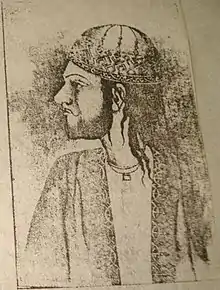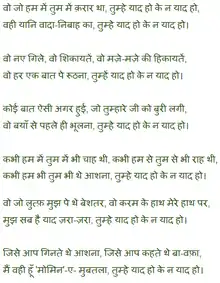Momin Khan Momin
Momin Khan Momin (Moʾmin Xān Moʾmin; 1800–14 May 1852) was a late Mughal era poet known for his Urdu ghazals. A lesser-known contemporary of Ghalib and Zauq, he used "Momin" as his pen name. His grave is located in the Mehdiyan cemetery in Maulana Azad Medical College, Delhi.[3]
Momin Khan Momin | |
|---|---|
 Momin Khan Momin | |
| Born | 1800 Delhi, Mughal Empire, now India |
| Died | 14 May 1852 (aged 51–52) Delhi, Mughal Empire, now India |
| Resting place | Mehdiyan, Delhi, India |
| Occupation | Poet, writer and Hakim (physician)[1] |
| Genre | Philosophy, spiritualism |
| Notable works | Kulliyat-e-Momin (Momin's complete works of poetry)[2] |
Life
Momin Khan 'Momin' was born in Delhi into a Muslim family of Kashmiri origin.[4][5] His father, Ghulam Nabi Khan, was a Hakeem (physician of traditional/Unani medicine). Momin Khan received training in the family profession from a young age and himself became a hakim, due to which he is often referred to in contemporary accounts as "Hakeem Khan," Hakeem being the Urdu word for physician.[1] However, his bent was for poetry and he soon became known more as an accomplished poet. His interest received a fillip due to the associations he unwittingly gained through marriage.[1] In 1823, Momin married to a girl belonged to the family of zamindar (land owner). The marriage became unsuccessful, and he separated from his wife. He later married Anjuman-un-Nisa Begum, a relative of Urdu poet and Sufi saint Khwaja Mir Dard. They had a son, Ahmad Nasir Khan, and a daughter, Muhammadi Begum.[6] Momin died after accidentally falling from the roof of his house on 24 Rajab 1268 Hijri (14 May 1852) at the age of 52.[7]
Momin was something of a polymath, with several interests apart from medicine and poetry. He was also competent in mathematics, geomancy, astrology, chess and Hindustani music.[8][9][10][1]
Works

Momin’s main body of work includes a diwan and six masnavis.[11]
Momin is known for his particular Persianized style and the beautiful use of his 'takhallus'. According to legend, Mirza Ghalib (his contemporary and also a rival) offered Momin his entire diwan (collection of poetry) in exchange for a particular verse of Momin. However, most modern poets believe this claim as an 'exaggeration' which poets commonly indulged in at that time. This exaggeration was usually done to emphasise some thing. The couplet in question was:
- تم میرے پاس ہوتے ہو گویا
- جب کوئی دوسرا نہیں ہوتا
- "Tum mērē pās hōtē hō gōyā
- Jab kō'ī dūsrā nahīⁿˡ hotā"[2]
which translates to:
- You are close to me [as if]
- When no one else is.[1]
This couplet's beauty is in its succinctness and multiple layers of meaning. One of the meanings is When you're with me(on my mind), no-one else is and a second meaning/interpretation is You are with me (on my side), when no-one else is. The two meanings emerge by the use of words gōyā and jab (when)."
One of his very famous ghazals starts with the following matla (the first line of the opening couplet of a ghazal).
- Woh jō ham mēⁿ tum mēⁿ qarār tḣā; tumhēⁿ yād hō, keh nah yād hō:
- Wohī, yaʿnī waʿdah nibāh kā; tumhēⁿ yād hō, keh nah yād hō[2]
- وہ جو ہم میں تم میں قرار تھا، تمہیں یاد ہو کہ نہ یاد ہو
- وہی یعنی وعدہ نباہ کا، تمہیں یاد ہو کہ نہ یاد ہو[2]
- That understanding which we had between us... whether you remember it or not...
- That promise of trust and faithfulness...whether you remember it or not...[2]
References
- Profile of Momin Khan Momin on allpoetry.com website Retrieved 20 May 2018
- Peerzada Salman (5 January 2017). "The triumvirate of Ghalib, Zauq and Momin". Dawn (newspaper). Pakistan. Retrieved 16 October 2021.
- "In the lanes of Zauq and Ghalib". Indian Express (newspaper). 15 March 2009. Archived from the original on 21 January 2012. Retrieved 20 May 2018.
- Abida Samiuddin, Encyclopaedic Dictionary of Urdu Literature, Global Vision Publishing House (2007), p. 342
- Kuldip Salill, A Treasury Of Urdu Poetry, Rajpal & Sons (2009), p.72
- Siddiqui, Zaheer Ahmad (1991). Momin Khan Momin (in Hindi). Translated by Sharma, Janaki Prasad. New Delhi: Sahitya Akademi. pp. 19–20. ISBN 81-7201-143-1.
- Diwan-e-Ghalib, compiled by Kalidas Gupta Riza, pg 90, Anjuman-i Taraqqi-i Urdu, Karachi (1997)
- K.C. Kanda, Masterpieces of Urdu Ghazal from the 17th to the 20th Century, Sterling (1992), p. 182
- Ali Jawad Zaidi, A History of Urdu literature, Sahitya Akademi (1993), p. 181
- D.J. Matthews, Urdu Literature, South Asia Books (1985), p. 86
- Saksena 1927, p. 149.
Cited sources
- Saksena, Ram Babu (1927). A History of Urdu Literature. Ram Narain Lal. ISBN 978-81-7435-161-6.